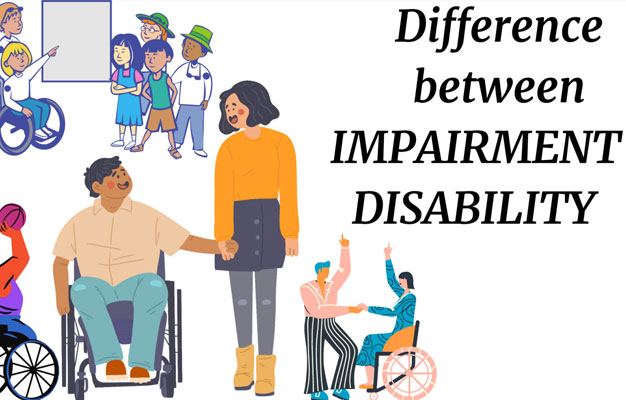
Distinguish between Impairment and Disability
Disability studies concerns with integration, inclusion and accessibility for persons with disability. As to state, what is disability? What causes disability? Many of us would say Impairment causes disability, partially correct. However, to understand it better, we should know the difference between the two.
Impairment could be defined as any loss of limb, sight, hearing or any abnormality of psychological function. On the contrary, disability is an outcome of that Impairment as limitation of a body part that confines any mobility and not to forget a failure of societal structure that doesn’t offer enough of accessibility which promotes disablism. To elucidate it better, let’s take an example of Tom Sullivan, an American Singer who published his life narrative, “If you could see what I hear” in 1975 and manifest the struggles he went through due to his impairment of sight. At numerous instances he experienced the segregation and explained the loneliness and pain of falls he had to bear because of inadequate facilities by society’s infrastructure, one of the main incidents was at Harvard, when he couldn’t find his way through and used to miss all the lectures. His impairment was the reason of his disability, but more than that it was the unfacilitated structure of the society. Likewise, Michael James Hoiles Oliver was a British sociologist, author, and disability rights activist. He was the first Professor of Disability Studies in the world, and key advocate of the social model of disability. He defines disability in his social model as it has nothing to do with the body and it’s all societal made, but the impairment has everything to do with the body. He is a wheelchair user who suffers the spinal cord injury, while discussing the social model in his “understanding disability”, he brings out the idea of disablist society and how they transform mere impairment into disability and cause of segregation. The fight they lead towards making everyone with disability “normal” by introducing special schools is nothing, but an escape from their duty of uplifting each other in the same environment and in the mainstreams.
There is learning impairment and then there is learning disability, learning impairment is due to the person’s own inability to decode the words in spite of being able to read them, on the other hand learning disability is due to lack of required instruments that could assist the person to read. The latter is failure of the government towards their disabled citizens and the first one is impairment. A wheelchair user doesn’t have his both legs that signifies his impairment, but he can’t join his friends in a party which is happening at the terrace, that’s a lack of accessibility which makes him a disabled. Impairment could be facilitated by assistive devices for the better functioning and disability could be minimalized by certain modifications which promotes accessibility to provide inclusion. If a person lost his both the legs, his impairment could be managed by prosthetic legs, but people’s perspective towards his disability is a complex task to change.
As far as it seems, disability is a wider term than impairment, as it covers diverse parts of our society and minds. Meanwhile impairment has its end points and conclusions. When it comes to disability there are many aspects of the society that needs to be considered and politics is one of the main parts of them all. Citizenship, provisions, policies, welfare, rights, personal struggles, etc. are some of the fundamentals on which one studies disability.
Impairment is a physical barrier, but disability is a societal barrier. As of now we are all aware of the fact that disability is not just an outcome of impairment, but a barrier that society imposes upon persons with disability. One of the major issues of non-accessibility in the working environment, educational institutions, public places, etc. creates barriers for persons with disability, unless and until these barriers are broken down, disablism isn’t leaving our society. If a person can’t walk that’s his body’s limitation a physical barrier. However, he can have his mobility by a wheelchair and if the place is not wheelchair accessible then that would be considered as a societal barrier.
Impairment is in body, but disability is in our minds. A man couldn’t walk, so what, he can crawl. But is it acceptable by society? No, because that isn’t very attractive or normal and it looks pitiable. A woman has to climb stairs with her hands, step by step on her hands, she climbs. Is it acceptable as normal? No, but why? Just because they opt for a different way as per to their convenience and ability? Doesn’t make the work any different. The work is to reach the destination and its done, then why does it seem to all so pitiable? Why couldn’t that person have a companion on that staircase with her? Why can’t you walk while he crawls? Impairment is real, but disability is an exaggerated emotion.
The importance of understanding the difference between Impairment and Disability is essential for betterment of the community in aspect of monetary benefits, employment, self-esteem and accessible environment for people. Only demolition of poverty from this community could remove this social stigma of weakness in society and the difference can be of realisation of their ability in workforce or in the mainstreams.
Source: by Sahil Attri – Master’s Student in English from One of his Critical Papers on Disability Studies.




